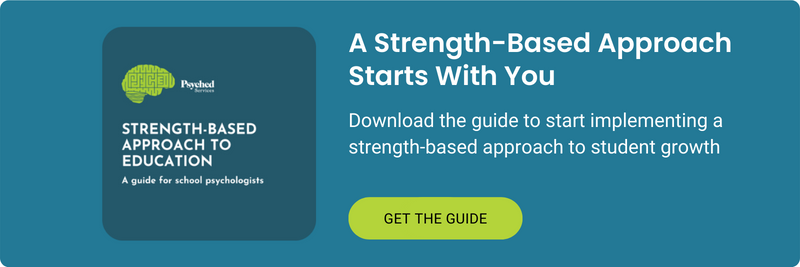Larry P. v. Riles, Part Two: Culturally Responsive Assessment

By Marysa Enis and Maria Gregory
May 2019
School psychologists do a disservice to the field, and more importantly, to children when they fail to acknowledge the realities of how children develop and are differently supported by communities and schools, particularly where race is concerned.
– Amanda L. Sullivan and Sherrie L. Proctor, 2016
The Problem
Across California, school psychologists are engaging in a decades long debate about how to assess intelligence in students who are African American. The discussions can get heated and are often fraught with misinformation. They include passionate and firmly held beliefs. They draw on personal experience. They almost always include a reference to lawyers. Above all else, they are missing the point.
Despite the fundamental intent of Larry P. v. Riles, students of color continue to be placed in special education classes at an unjustifiably high rate. On top of that, data on their outcomes is beyond troubling. They are segregated from peers, stigmatized, exposed to chaotic learning environments, and treated as less capable than others. Once placed in special education, it’s not likely that they will receive research-based intervention, but very likely they will remain in special classes for their entire education. As sworn advocates for children, what can school psychologists do to invoke true and lasting change?
Challenging Assumptions
We can start by getting on the same page. There are many firmly held beliefs about assessment of African American students in California, but are they true? To find out, we poured through Larry P. v. Riles court documents and subsequent rulings, reviewed the California Department of Education (CDE) compliance guidelines, compared SELPA Procedural Guides, searched the Office of Administrative Hearings (OAH) due process files, studied past National Association of School Psychologists (NASP) journal articles, located recommendations from local law firms, quizzed our fellow school psychs, and interviewed top professionals in the field. We are especially grateful to the wealth of information provided by the California Association of School Psychologists (CASP), who has been researching and advocating on this topic for years. Here is what we found:
-
Myth: It is illegal to give an IQ test to an African American student in California for any reason.
False. The Larry P. ruling is specific to assessment of intellectual disabilities (or, as it was called at the time, educable mental retardation) and placement into “dead-end” classes. Although there was another court case which extended the ban to include all special education evaluations (1986), the judge later rescinded the ban (1992), stating that it violated the rights of parents who wanted assessment for learning disabilities.Even so, the California Department of Education (CDE) prohibits the use of IQ tests for any special education evaluation (see Compliance Guidelines), so districts run the risk of being sanctioned by the CDE if they do not comply. “Dead-end classes” are defined by the court as those in which:
-
Students typically do not receive the regular curriculum and fall farther and farther behind students in the regular class;
-
Fewer than 20% of students are returned to the regular classroom, and;
-
African Americans are disproportionately represented
-
Myth: Schools may not use IQ tests to assess African American students for gifted and talented education (GATE).
African American students are under identified in programs for children who are gifted. If anyone is using the Larry P. ruling as an excuse not to consider assessment for giftedness, it’s time to stop now. The CDE ban is only relevant to assessments which could lead to special education placement or services. The rationale is twofold:
- Even if assessment is intended to be for a different disability category (such as Other Health Impairment or Specific Learning Disability), the end result could be identification of ID
- Any special education evaluation has the potential to result in placement into restrictive classes, some of which meet the court’s definition of a “dead-end” programming
In searching CDE guidelines, we did not find a specific reference to assessment for GATE. However, by its very nature, a GATE assessment could not result in placement into special education.
-
Myth: Professionals agree about what constitutes an IQ test.
Not even close, which was incredibly shocking to us. As school psychologists, we are taught that the words intelligence and cognitive ability are synonymous. The Larry P. v. Riles ruling uses the words IQ test and standardized tests of intelligence interchangeably, but you won’t find the words cognitive ability anywhere in the court document. In reviewing CDE and SELPA Guidelines, you will find these, and other, terms used in a variety of ways. Maybe that’s why professionals have started parsing the terms, or maybe not, but either way, they are definitely being parsed.
-
Myth: School psychologists will lose their credentials if they give the “wrong” test to a student who is African American.
It is highly unlikely, and there is certainly no evidence of it that we have found. There is, of course, the list of absolutely non-negotiable “no-no” tests (CDE ComplianceGuidelines), but we don’t think any school psych has been brazen enough to use one of those (who knows what would happen if they did?).
When it comes to the more questionable (and hotly debated) tests, like the Differential Ability Scales, 2nd Edition (DAS-2) or Cognitive Assessment System, 2nd Edition (CAS-2), many SELPAs and school psychologists have been unabashedly using them for years without repercussion. In cases where districts did face repercussion, it came about because of a due process hearing that was brought for another reason. In those cases, the CDE may require districts to complete corrective action (such as reassessing all students who are African American), but they aren’t in the habit of removing practitioner credentials.
It’s difficult to determine how often districts are sanctioned or what type of corrective action is most common, but from what we’ve seen in due process, it seems clear that the CDE’s goal is simply to ensure that schools stay true to the spirit of Larry P. v. Riles. That may mean they get support from an outside agency, such as the State Performance Plan-Technical Assistance Program, to find ways to improve.
-
MYTH: Schools may not consider the results of private evaluations that contain IQ tests.
False. Due process hearings illustrate that IEP teams must meet to consider the results of private evaluations, even if those results include an IQ test. This is a federal right under IDEA. That said, it is not clear how schools should document outside reports or to what extent they should be redacted. To us, the guidelines seem to suggest that tests should not be mentioned by name. We reached out to the CDE for clarification and will add their response when it is available.Current wording states that schools must redact all scores (subtests and composites), including age equivalents, grade equivalents, percentile ranks, and standard scores, and all references to information from IQ tests, which includes:
- Any reference to a test instrument which yields a cognitive, mental ability, or aptitude score or standard score that is an indication of cognitive functioning
- Any test data summary scores from the test instruments
- Commentary in the report, which discusses the pupil’s performance on the test instruments
-
Myth: Assessment tools, including IQ tests, are no longer culturally biased.
False. Assessment practices have certainly come a long way since the 1960’s, in no small part thanks to the efforts of parents and the Association of Black Psychologists in the monumental Larry P. v. Riles ruling. Before the ruling, there was a huge (one standard deviation) difference in scores between caucasians and African Americans, which white psychologists were making no effort to address (and worse, were justifying with racist ideology). Now, as a result of Larry P. v. Riles, test developers not only obtain and report norms for each group represented by the US census, they employ experts in cultural and linguistic bias.
With these changes, current norms show up to a 0.5 standard deviation difference in scores, which most school psychologists are trained to recognize and consider. What we arguably aren’t trained to recognize, however, is the very real possibility of being mislead by cultural bias in rating scales. This is a huge concern as rating scales help guide many assessment decisions, particularly in cases where IQ tests are off the table.
Challenging Biased Assessment Practices
Unfortunately, biased and discriminatory practices start long before African American children are referred for assessment. Data shows that once a child is referred, school psychologists are likely to find evidence of a disability, and it’s not yet clear how to change that. Statistics show that we would find evidence of a disability in any random sample of children, but in the case of special education referrals, the sample isn’t random. It’s hand-picked for us by potentially biased parents and teachers, and most assuredly by biased systems.
We gave some ideas for addressing bias in Part One: Disproportionality, but there are many more specific ways school psychologists can help. Here are some places to start:
-
Advocate to be part of the Multi-Tier System of Supports process
We know that school psychologists are beyond busy and school-wide systems are slow to change, but fewer inappropriate referrals means more time for helping build school-wide systems that actually help children. Schools with high rates of disproportionality are required to use 15% of their special education funds for pre-referral services. Ask to be a part of those services. Some local districts are fostering culturally responsive school climates through seminars and trainings, such as Courageous Conversations. The Hechinger Report is a good resource for ideas to combat inequality in education. Read Teachers go to School on Racial Bias for other ideas.
-
Look for problems within the school environment
Don’t automatically assume that parent and teacher concerns reflect deficits within a child. Take a step back and reflect on the school’s needs. What are the academic and behavioral expectations? What school-wide supports are utilized? What behavior management and teaching techniques are employed? Be prepared for the very real possibility that a classroom or school culture discriminates against culturally and linguistically diverse students.
Consider:
- Quality of teacher training and experience
- Quality of curriculum and instructional design
- Approach to discipline
- Quality of parent outreach and support
- Diversity of beliefs, values, and communication styles supported from the top down
- Match between student beliefs, values, and communication styles and those of the predominant culture of the school
-
Reexamine your tools
When is the last time you checked the technical manuals of your tests? What are the norming samples? How do the test makers intend for their tests to be used? If you’ve been out of graduate school for a while, there is a decent chance you’ve forgotten a lot of this stuff, and the norms might not be as great as you think. On top of that, long-time clinicians are susceptible to examiner drift, meaning that we tend to become more sloppy in our administration procedures over time. Use the Analysis of Test Reliability and Validity from the Diagnostic Center Northern California to examine the tests you use.
-
Determine local norms
Reducing bias in testing means going heavy on interviews and observations, and not just with parents and teachers. Get to know members of the community. Seek to understand parenting styles, family values, and attitudes toward education. Observe in as many settings as possible, then consider how a student’s behavior and learning compares with others in that setting. It is essential for clinicians to understand and view a student’s history through the lens of local norms (including class averages, attendance, behavior, etc.).
-
Focus on student strengths
By nature, special education evaluations are set up so that we focus on student weaknesses. In doing so, we run the risk of judging a child’s personal characteristics (like speech, gestures, facial expressions, behavior, and appearance) harshly based on our own unconscious stereotypes. When observing, pay attention to what a child can, rather than can’t, do. Notice how they approach tasks and respond to their environment. Interview everyone who cares for the child, including parents, older siblings, coaches, counselors, or administrators. To off-set potentially biased systems, evaluate student needs through dynamic assessment and a mediated learning experience. We’ve recently learned that there are strength-based and resiliency rating scales, too. We’ll explore those, and other tools, in our next article.
-
Use standardized tools to test, rather than develop, hypotheses
Once you have gathered ample qualitative and authentic data (including observations and interviews, work samples, records review, developmental history, and comparison with local norms), look for patterns and develop hypotheses. Choose standardized tools that answer remaining questions and help test hypotheses, and avoid choosing tools just because they meet a predetermined check-list. When you choose tools, make sure you understand their limitations when it comes to assessing students with culturally and linguistically diverse backgrounds.
Change is taking place. The movement is away from labeling and isolation and toward education to meet individual needs. The future of special education may be a brighter one.
– Judge Peckham, Larry P. v. Riles, 1979
Is your school ready to make a change? Our seasoned school psychologists and BCBA’s would love to help! It’s crucial to collect the right data and know what to do with it. Click here to schedule a free consultation about what Psyched Services can do for you.





